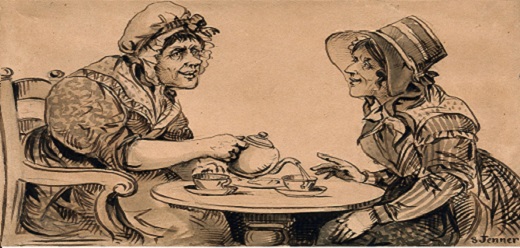
Hunger and starvation occupy a pivotal position in the Irish collective memory, for reasons including the Famine and hunger strikes. However, outside of these times of unusual crisis, the prospect of starvation loomed for many people. In modern Irish history, hunger has too often been a normal, rather than exceptional, condition, one that has recently re-emerged during the current cost-of-living crisis.
The century after the Famine saw numerous crisis points during which food became sparse or expensive: the 19th-century economic depressions, First World War, Dublin Lockout, the 1930s’ Great Depression, for example. Hunger posed difficult questions. What were the cheapest foods available? Were they nutritious? Was nutrition important when struggling to physically survive? Was starving to death better than entering the workhouse? In the context of these awful, unanswerable questions, many families descended into a life of frugal diets, lacking in nutrition and typically consisting of tea and white bread. The dreaded ‘tea and white bread’ diet signalled an impending descent towards unthinkable levels of impoverishment and hunger, perhaps even death from starvation.
One might presume that such families would have received much sympathy. Sadly, this wasn’t the case. Between the 1830s and 1860s, per capita consumption of tea rose in Ireland from 0.5 pounds to 2.2 pounds and continued rising throughout the century.[1] ‘Tea addiction’ emerged as a central concern in late-nineteenth century discussion of working-class diets. Across the industrialising west, physicians warned of the dangers of ‘excessive tea drinking’. In Ireland, these debates emerged against a backdrop of rapid dietary change following the Famine.[2]
At the time, physicians were still figuring out which foodstuffs were safe, addictive, suitable for general consumption or best used for medicinal purposes only. Whereas alcohol was clearly addictive and socially disruptive, tea seemed more ambiguous. It didn’t cause as many social problems as alcohol. Being boiled, it was safer than water, but, when consumed in particular ways, was nonetheless potentially health threatening.[3]
Tea and Mental Health
The poorest Irish people stewed cheap, unhealthy concoctions of tea all day long on their stoves, consuming little else but a few slices of processed white bread. Physicians considered the tannic acid contained in tea (alongside the ‘theine’ or caffeine) to be highly addictive.[4] Some feared that excessive tea drinking was a first step on a slippery slope towards more serious addictions such as chronic alcoholism. Instead of reflecting much upon the impacts of socio-economic factors on dietary behaviour, most physicians accused the working classes of drinking tea not from sheer necessity but instead for the psychological thrill of mental exhilaration (or a ‘high’).[5] Doctors warned that excessive tea drinking shattered the nerves, even causing ‘tea mania’. Symptoms included diminished self-restraint, nervousness, undue sensitiveness, timidity, uncontrollable emotions, giddiness, headache, ringing in the ears, severe neuralgia and tremulousness.[6]
In October 1883, the Dean of Bangor, Henry Edwards, attracted international interest after announcing that excessive tea drinking had created ‘a generation of nervous, discontented people’. ‘Over much tea drinking’, explained the Dean, ‘by destroying the calmness of the nerves, is acting as a dangerous, revolutionary force among us’. The Dean blamed ‘ignorant wives’ for not cooking properly, driving their husbands to the pub for sustenance, and leading families into ‘ruin, intemperance and disease’.[7] The Dean’s message was widely reported across Ireland, at a time when concern was deepening about Irish tea consumption levels during the economic depression of the 1880s. The Irish Times warned: ‘Tea-making to excess among this class is a form of laziness which produces, there can be no doubt about it’, adding that ‘it takes too much the place of solid food’.[8] Reports emerged of washerwomen, kitchen girls and mothers filling the out-patient departments of Belfast’s hospitals complaining of headache, nausea, loss of appetite, physical distress after eating and chronic dizziness.[9]
In the 1890s, Dublin Castle authorised an official enquiry into rising asylum admissions across Ireland. Almost all asylum owners blamed these upon widespread reliance on poor-quality Indian tea, stewed rather than infused, responsible for creating chronic forms of dyspepsia nationwide that debilitated nervous systems, causing the so-called ‘insanity of malnutrition’.[10] Most puzzling and worryingly, the asylums were filling at a time when the population was declining rapidly due to emigration.[11]
Derogatory reports concealed the heart-wrenching decisions being made by mothers to economise, and to go without themselves. Mothers served the most nutritious food to other household members: fathers who needed strength for the workplace, the young to ensure healthy physical growth. Mothers sacrificed their own health. Tea suppressed their appetite and quelled hunger pangs. Rather than recklessly seeking hedonistic pleasure, these families were navigating, to borrow a modern term, ‘food poverty’.
Twentieth-Century Hunger
The experience of Irish hunger was encapsulated in James Esse’s poignant 1918 story, Hunger: A Dublin Story. Written from the perspective of a budgeting housewife, Hunger described a family living ‘just over the death line of starvation’. In one telling passage, Esse described how usual and common feeling hungry was, so much so that the poorest accepted it as a way of life, part of nature even. In Esse’s words:
She had not known for three years what it was like not to be hungry for one day, but life is largely custom, and neither she nor her husband, nor the children, made much complaint about a condition which was normal for them all, and into which the children had been born.
As the First World War broke out, times became even tougher. The family were already living in hunger, but rising prices meant that more food needed to be removed from the grocery bill, but what? The youngest child then died from a hunger-related disease; the wife went out begging in the streets. Some days, she scraped together enough for a little tea and white bread. Her second child died of hunger; her husband was found dead from hunger and exposure.[12]
A sad fact in modern Irish history is that reports of starvation remained woefully common until well into the 1940s. In 1925, children in Clonmel were reported dying from starvation.[13] Starvation in the streets of Portadown was nationally discussed in 1928.[14] Throughout the 1920s and 1930s, Belfast’s working classes struggled to maintain an adequate diet when facing urban economic distress.[15]
Pensioners were especially vulnerable, a problem worsened by the Irish state making staggering pension cuts in the 1920s.[16] In 1925, an elderly Ennis couple were found living in filth, having resorted to eating from a calf’s carcass lying in their kitchen, in a house with no windows or roof.[17] In 1929, 75-year-old Mary A. Gaskin was found dead in a Temple Bar, Dublin, tenement house, her corpse revealing visible signs of malnutrition.[18] In 1933, a 85-year-old Waterford man, Patrick Kennedy, died after being discovered in a frail state in his house, which contained no mattress or bed clothing. Rain poured in through holes in the roof. A small amount of flour was the only food in his possession.[19] Such examples are illustrative of the reports published in national and local newspapers in interwar Ireland, revealing how common, rather than exceptional, hunger and starvation was in relatively recent times.
Although late-twentieth-century discussion coalesced more around the consequences of over-eating (e.g. obesity), we once again find ourselves facing a severe cost-of-living crisis that is forcing families to make challenging decisions about eating, budgeting and going without. History, and humanities approaches, are needed to help us better understand the day-to-day experiences of hunger, to counter the victim-blaming narratives through which personal experiences are too often mediated, and to interrogate the implications of a lack of adequate state support for vulnerable hungry people.
[1] Leslie A. Clarkson and E. Margaret Crawford, Feast and famine: A history of food and nutrition in Ireland, 1500-1920 (Oxford: Oxford University Press, 2001), pp. 103-5.
[2] Ian Miller, Reforming food in post-Famine Ireland: Medicine, science and improvement, 1845-1922 (Manchester: Manchester University Press, 2015).
[3] Ian Miller, 'Tea, addiction and late-Victorian narratives of degeneration, c.1860-1900', in Geoffrey Hunt, Tamar M.J. Antin and Vibeke Asmussen Frank (eds), Routledge history of intoxication (London: Routledge, 2022), pp 564-80.
[4] Ian Miller, ‘‘A dangerous revolutionary force amongst us’: Conceptualising working-class tea drinking in the British Isles, c.1860-1900’, Cultural and Social History, 10:3 (2013), pp. 419-38.
[5] ‘Midland Scientific Association’, Derby Mercury (22 Apr. 1863), p. 2.
[6] ‘Neuralgia and tea’, Observer (26 Jul. 1908), p. 12.
[7] ‘The Dean of Bangor on the evils of tea-drinking’, Berrow’s Worcester Journal (13 Oct. 1883), p. 7.
[8] Irish Times (20 Oct. 1883), p. 3.
[9] ‘The abuse of tea’, Belfast Newsletter (27 Sept. 1887), p. 6.
[10]Alleged increasing prevalence of insanity in Ireland: Special report from the Inspectors of Lunatics to the Chief Secretary, Reports of Commissioners, House of Commons, 1894, C.7331, vol. xliii.647, pp. 4-5.
[11] Thomas Drapes, ‘On the alleged increase of insanity in Ireland’, Journal of Mental Science 40:171 (Oct. 1894), pp. 519-48: 535-6.
[12] James Esse, Hunger: A Dublin story (Dublin: Candle Press, 1918).
[13] ‘Children die from starvation’, Irish Independent (8 Aug. 1925), p. 7.
[14] ‘Distress in Portadown, but no starvation,’ Irish Times (21 Nov, 1928), p. 11.
[15] ‘Belfast poverty and starvation: Influenza adds to people’s misery’, Irish Times (30 Jan. 1929), p. 5.
[16] Cormac Ó’Gráda, ‘The greatest blessing of all: The old age pension in Ireland,” Past and Present 175:1 (May 2002), pp. 124-61.
[17] ‘Deaths from starvation: Revolting conditions in County Clare’, Irish Times (16 Jan. 1925), p. 8.
[18] ‘Died from Starvation: Inquest on destitute Dublin old woman’, Irish Times (14 Feb. 1929), p. 5.
[19] ‘Death from slow starvation: Shocking conditions’, Irish Times (4 Jan. 1933), p. 5.


